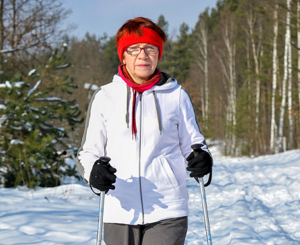 Promises Promises…
Promises Promises…
It’s no surprise to many of us that, year after year, the number one New Year’s Resolution is…
(drum roll please…)
- Lose Weight and Get Fit
It’s the most common New Year’s resolutions. After a season of way too many cookies, candies and holiday parties, it’s only natural that a vow to lose weight and get fit would follow. Each January, fitness clubs offer deals and promotions to those who want to make good on their resolutions only to find the participation level dwindle starting as early as February.
Starting or maintaining a regular exercise routine can be a challenge at any age—and it doesn’t get any easier as you age. You may feel discouraged by health problems, aches and pains; concerned about injuries or falls.
While these may seem like good reasons to slow down and take it easy as you age, they’re even better reasons to get moving. Becoming more active can energize your mood, relieve stress, help you manage symptoms of illness and pain, and improve your overall sense of well-being.
It’s about adding more movement and activity to your life, even in small ways. No matter your age or physical condition, it’s never too late to get your body moving and improve your health and outlook. It can help boost your energy, maintain your independence, protect your heart, and manage symptoms of illness or pain as well as your weight. And, regular exercise is also good for your mind, mood, and memory.
A good way to keep you on track in getting fit for 2017 is to dispel some of the myths about exercise or activity and aging.
Myth 1: There’s no point to exercising. I’m going to get old anyway.
Fact: Regular physical activity helps you look and feel younger and stay independent longer. It also lowers your risk for a variety of conditions, including Alzheimer’s and dementia, heart disease, diabetes, certain cancers, high blood pressure, and obesity.
Myth 2: Exercise puts me at risk of falling down.
Fact: Regular exercise, by building strength and stamina, prevents loss of bone mass and improves balance, actually reducing your risk of falling.
Myth 3: It’s too frustrating: I’ll never be the athlete I once was.
Fact: Changes in hormones, metabolism, bone density, and muscle mass mean that strength and performance levels inevitably decline with age, but that doesn’t mean you can no longer derive a sense of achievement from physical activity or improve your health. The key is to set lifestyle goals that are appropriate to your age. And remember: a sedentary lifestyle takes a much greater toll on athletic ability than biological aging.
Myth 4: I’m too old to start exercising.
Fact: You’re never too old to get moving and improve your health! In fact, adults who become active later in life often show greater physical and mental improvements than their younger counterparts. Just begin with gentle activities and build up from there.
Myth 5: I can’t exercise because I’m disabled.
Fact: Chair-bound people face special challenges but can lift light weights, stretch, and do chair aerobics, to increase range of motion, improve muscle tone and flexibility, and promote cardiovascular health. Many swimming pools offer access to wheelchair users and there are adaptive exercise programs for wheelchair sports.
Myth 6: I‘m too weak or have too many aches and pains.
Fact: Getting moving can help you manage pain and improve your strength and self-confidence. Many older people find that regular activity not only helps stem the decline in strength and vitality that comes with age, but actually improves it. The key is to start off gently.
So, for 2017, make a commitment to a better, healthier you by starting and finishing the year with a fitness plan.
You can do it!
Food for thought…
“We do not stop exercising because we grow old, we grow old because we stop exercising.” Dr. Kenneth Cooper
…wishing you a happy and healthy New Year!

